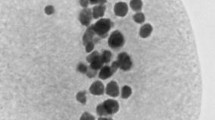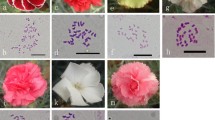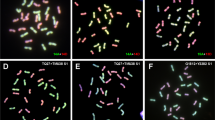Abstract
The chromosomes of diploid and established artificial autotetraploidT. cacao were examined with particular attention to their shapes and relative sizes at mitotic metaphase, as well as their association during metaphase of male meiosis. Bivalent formation was observed in the diploid, and although there was low apparent chiasma frequency, disjunction was regular. In the two established autotetraploids studied, there was a high frequency of bivalents as compared with trivalents and quadrivalents. Pollen fertility as measured by its germination on agar was between 38 and 64 percent (diploid 90–98.5 percent). Fruit set was between 11.5 and 19.1 percent (diploid 74 percent), and mature bean number was approximately half the ovule number counted (diploid 90 percent). Seed germination was, however, never less than 77 percent at any particular sowing and almost all the seedlings had 4x chromosome number. It is suggested that an improvement in the yield capacity of the autotetraploid might be possible by crossing C1 tetraploid individuals selected on the basis of the frequency of bivalent formation, as well as uniformity in pollen size and fertility.
Similar content being viewed by others
References
Cheesman, E. E. (1927). Fertilisation and embryogeny of Theobroma cacao L.Ann. Bot. 41: 101–125.
Cope, F. W. (1962). The mechanism of pollen incompatibility in Theobroma cacao L.Heredity 17: 157–182.
Davis, J. H. (1935). Chromosome studies in Malvaceae and certain related families. II.Genetics 17: 487–498.
Dowrick, G. J. (1957). The influence of temperature on meiosis.Heredity 11: 37–49.
Hazarika, M. H. &H. Rees (1967). Genotypic control of chromosome behaviour in rye. X. Chromosome pairing and fertility in autotetraploids.Heredity 22: 317–332.
Henderson, S. A. (1963). Chiasma distribution at diplotene in a locust.Heredity 18: 173–190.
Knight, R. (1957). Induced polyploidy in Theobroma cacao L. and related species.J. hort. Sci. 32: 1–8.
Knight, R. &H. H. Rogers (1955). Incompatibioity in Theobroma cacao.Heredity 9: 69–77.
Lam, S. (1972). Meiosis in a diploid potato.J. Hered. 63: 205–208.
Opeke, L. K. &V. J. Jacob (1967). Cytological irregularities in Theobroma cacao. International cacao conference, 1967, 114–115.
Rees, H. &J. B. Thompson (1956). Gametophytic control of chromosome behaviour in Rye. III. Chiasma frequency in homozygotes and heterozygotes.Heredity 10: 409–424.
Riley, R. &C. N. Law (1965). Genetic variation in chromosome pairing.Adv. Genet. 13: 57–114.
Sharma, A. K. &A. Sharma (1965). Chromosome techniques, Theory and practice. Butterworths, London.
Swanson, C. P. (1968). Cytology and Cytogenetics. Macmillan, London.
Author information
Authors and Affiliations
Rights and permissions
About this article
Cite this article
Martinson, V.A. Cytological studies of diploid and tetraploidTheobroma cacao . Genetica 45, 341–348 (1975). https://doi.org/10.1007/BF01508308
Received:
Accepted:
Issue Date:
DOI: https://doi.org/10.1007/BF01508308




